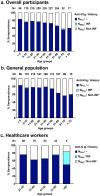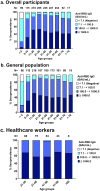Seroprevalence of SARS-CoV-2 anti-nucleocapsid total Ig, anti-RBD IgG antibodies, and infection in Thailand: a cross-sectional survey from October 2022 to January 2023
- PMID: 37730917
- PMCID: PMC10511501
- DOI: 10.1038/s41598-023-42754-2
Seroprevalence of SARS-CoV-2 anti-nucleocapsid total Ig, anti-RBD IgG antibodies, and infection in Thailand: a cross-sectional survey from October 2022 to January 2023
Abstract
Seroprevalence studies on SARS-CoV-2 are essential for estimating actual prevalence rates of infection and vaccination in communities. This study evaluated infection rates based on total anti-nucleocapsid immunoglobulin (N) and/or infection history. We determined the seroprevalence of anti-receptor binding domain (RBD) antibodies across age groups. A cross-sectional study was conducted in Chonburi province, Thailand, between October 2022 and January 2023. Participants included newborns to adults aged up to 80 years. All serum samples were tested for anti-N total Ig and anti-RBD IgG. The interviewer-administered questionnaires queried information on infection history and vaccination records. Of 1459 participants enrolled from the Chonburi population, ~ 72.4% were infected. The number of infections was higher in children aged < 5 years, with evidence of SARS-CoV-2 infection decreasing significantly with increasing age. There were no significant differences based on sex or occupation. Overall, ~ 97.4% of participants had an immune response against SARS-CoV-2. The anti-RBD IgG seroprevalence rate was lower in younger vaccinated individuals and was slightly increased to 100% seropositivity at ages > 60 years. Our findings will help predict the exact number of infections and the seroprevalence of SARS-CoV-2 in the Thai population. Furthermore, this information is essential for public health decision-making and the development of vaccination strategies.
© 2023. Springer Nature Limited.
Conflict of interest statement
The authors declare no competing interests.
Figures




Similar articles
-
SARS-CoV-2 infection- induced seroprevalence among children and associated risk factors during the pre- and omicron-dominant wave, from January 2021 through December 2022, Thailand: A longitudinal study.PLoS One. 2023 Apr 27;18(4):e0279147. doi: 10.1371/journal.pone.0279147. eCollection 2023. PLoS One. 2023. PMID: 37104299 Free PMC article.
-
Prevalence of antibodies against SARS-CoV-2 in the Norwegian population, August 2021.Influenza Other Respir Viruses. 2022 Nov;16(6):1004-1013. doi: 10.1111/irv.13024. Epub 2022 Jun 30. Influenza Other Respir Viruses. 2022. PMID: 35770841 Free PMC article.
-
Seroprevalence of IgG antibodies against SARS-CoV-2 among the general population and healthcare workers in India, June-July 2021: A population-based cross-sectional study.PLoS Med. 2021 Dec 10;18(12):e1003877. doi: 10.1371/journal.pmed.1003877. eCollection 2021 Dec. PLoS Med. 2021. PMID: 34890407 Free PMC article.
-
Seroprevalence of SARS-CoV-2-specific anti-spike IgM, IgG, and anti-nucleocapsid IgG antibodies during the second wave of the pandemic: A population-based cross-sectional survey across Kashmir, India.Front Public Health. 2022 Oct 6;10:967447. doi: 10.3389/fpubh.2022.967447. eCollection 2022. Front Public Health. 2022. PMID: 36276377 Free PMC article.
-
SARS-CoV-2 Infection-and mRNA Vaccine-induced Humoral Immunity among Schoolchildren in Hawassa, Ethiopia.Front Immunol. 2023 Jun 15;14:1163688. doi: 10.3389/fimmu.2023.1163688. eCollection 2023. Front Immunol. 2023. PMID: 37398668 Free PMC article.
Cited by
-
Seroprevalence of antibodies against varicella zoster virus across all age groups during the post-COVID-19 pandemic period in Chonburi Province, Thailand.Hum Vaccin Immunother. 2024 Dec 31;20(1):2367283. doi: 10.1080/21645515.2024.2367283. Epub 2024 Jul 25. Hum Vaccin Immunother. 2024. PMID: 39051458 Free PMC article.
-
SARS-CoV-2 Antibody Dynamics after COVID-19 Vaccination and Infection: A Real-World Cross-Sectional Analysis.Vaccines (Basel). 2023 Jun 30;11(7):1184. doi: 10.3390/vaccines11071184. Vaccines (Basel). 2023. PMID: 37515001 Free PMC article.
-
Age associated SARS-CoV-2 immune responses provide insights into population immunity over four years since the COVID-19 pandemic.Sci Rep. 2025 Jul 2;15(1):23183. doi: 10.1038/s41598-025-05737-z. Sci Rep. 2025. PMID: 40604011 Free PMC article.
-
Neutralization of omicron subvariants and antigenic cartography following multiple COVID 19 vaccinations and repeated omicron non JN.1 or JN.1 infections.Sci Rep. 2025 Jan 9;15(1):1454. doi: 10.1038/s41598-024-84138-0. Sci Rep. 2025. PMID: 39789099 Free PMC article.
-
Age-Specific Seroprevalence of Measles, Mumps, and Rubella IgG across All Age Groups in Chonburi Province, Thailand after the Coronavirus Disease 2019 Pandemic.Am J Trop Med Hyg. 2025 Apr 8;112(6):1385-1390. doi: 10.4269/ajtmh.25-0005. Print 2025 Jun 4. Am J Trop Med Hyg. 2025. PMID: 40203819
References
-
- WHO Coronavirus (COVID-19) Dashboard, https://covid19.who.int/ (2023).
Publication types
MeSH terms
Substances
LinkOut - more resources
Full Text Sources
Medical
Miscellaneous

